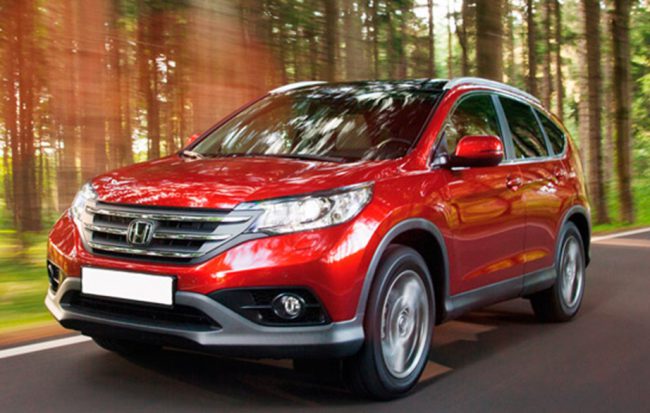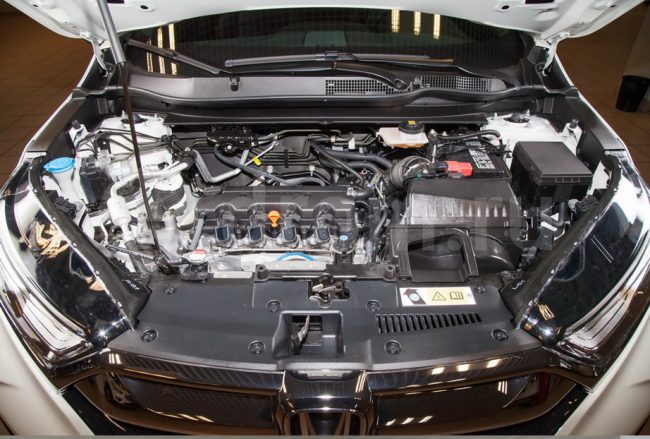
Honda CR-V engines
Content
The Honda CR-V is a five-seat small Japanese crossover that has been in such high demand that it has been produced since 1995 to this day. The SRV model has 5 generations.
History Honda CR-V
The abbreviation "CR-V" in translation from English stands for "small recreational car." The production of this model is carried out in several countries at once:
- Japan;
- United Kingdom;
- USA;
- Mexico;
- Canada;
- China.
The Honda CR-V is a cross between a small HR-V and an imposing Pilot. The car is produced for most regions, including Russia, Canada, China, Europe, USA, Japan, Malaysia and so on.
The first version of Honda SRV
The first version of this car from Honda was presented as a concept back in 1995. It is worth noting that the SRV was the first-born in the line of crossovers, which was designed by Honda without outside help. Initially, it was sold exclusively in Japanese dealerships and was considered as a premium class, since, due to its dimensions, it exceeded the legally established standards. In 1996, a model for the North American market was unveiled at the Chicago Motor Show.

It should be noted that the first generation of this model was produced in only one configuration, called "LX" and was equipped with a gasoline in-line four-cylinder engine "B20B", with a volume of 2,0 liters and a maximum power of 126 hp. In fact, it was the same 1,8-liter internal combustion engine that was installed on the Honda Integra, but with some modifications, in the form of an expanded cylinder diameter (up to 84 mm) and a one-piece sleeve design.
The car body is a load-bearing structure reinforced with double wishbones. The signature style of the car is the plastic lining on the bumpers and fenders, as well as folding rear seats and a picnic table, which was located in the lower part of the trunk. Later, the release of the CR-V in the “EX” configuration was adjusted, which was equipped with an ABS system and alloy wheels. The car also had an all-wheel drive system (Real-Time AWD), but versions were also produced with a front-wheel drive layout.
Below is a table showing the main characteristics of the B20B engine, which was installed on the first version of the SRV and after the restyled B20Z power unit:
| ICE name | B20B | B20Z |
|---|---|---|
| Engine displacement, cc | 1972 | 1972 |
| Power, HP | 130 | 147 |
| Torque, N * m | 179 | 182 |
| Fuel | AI-92, AI-95 | AI-92, AI-95 |
| Economy, l / 100 km | 5,8 – 9,8 | 8,4 – 10 |
| Cylinder diameter, mm | 84 | 84 |
| Compression ratio | 9.5 | 9.6 |
| The piston stroke, mm | 89 | 89 |
In 1999, the first generation of this model was restyled. The only change in the updated version was an upgraded engine, which added a little more power and slightly increased torque. The motor acquired an increased compression ratio, the intake manifold was replaced, and the exhaust valve lift was also increased.
The second version of the Honda SRV
The next version of the SRV model became a little larger in overall dimensions and gained weight. In addition, the design of the car was completely changed, its platform was transferred to another Honda model - Civic, and a new K24A1 engine appeared. Despite the fact that in the North American version it had a power of 160 hp and 220 N * m of torque, its fuel-economic characteristics remained at the level of the previous power units. All this is implemented using the i-VTEC system. Below is a schematic representation of how it works:
Due to the more thoughtful design of the rear suspension of the car, the trunk volume was increased to 2 thousand liters.
For reference! Authoritative publication Car and Driver in 2002-2003. named the Honda SRV as "Best Compact Crossover". The success of this car prompted Honda to release a more budget version of the Element crossover!
Restyling of this generation CR-V took place in 2005, which led to a change in the front and rear optics, the radiator grille and front bumper were updated. The most important innovations from a technical point of view are the electronic throttle, an automatic transmission (5 steps), a modified all-wheel drive system.

Below are all the power units that this model was equipped with:
| ICE name | K20A4 | K24A1 | N22A2 |
|---|---|---|---|
| Engine displacement, cc | 1998 | 2354 | 2204 |
| Power, HP | 150 | 160 | 140 |
| Torque, N * m | 192 | 232 | 340 |
| Fuel | AI-95 | AI-95, AI-98 | Diesel fuel |
| Economy, l / 100 km | 5,8 – 9,8 | 7.8-10 | 5.3 – 6.7 |
| Cylinder diameter, mm | 86 | 87 | 85 |
| Compression ratio | 9.8 | 10.5 | 16.7 |
| The piston stroke, mm | 86 | 99 | 97.1 |
The third version of the Honda SRV
The third generation CR-V was produced from 2007 to 2011 and differed in that the model became noticeably shorter, lower, but wider. In addition, the trunk lid began to open up. Among the changes, one can also note the lack of sound insulation and the presence of a through passage between the rows of seats.

This crossover in 2007 became the most popular in the American market, overtaking the Ford Explorer, which held the leading position for fifteen long years.
For reference! Due to the huge demand for the CR-V model, Honda even put the new Civic model on hold in order to use additional production capacity and satisfy the interest among buyers!
Restyling of the third generation of the SRV brought a number of design changes, including bumpers, grille, and lights. The engine power was increased (up to 180 hp) and at the same time fuel consumption decreased.
Below is a table of engines for this generation:
| ICE name | K20A4 | R20A2 | K24Z4 |
|---|---|---|---|
| Engine displacement, cc | 2354 | 1997 | 2354 |
| Power, HP | 160 – 206 | 150 | 166 |
| Torque, N * m | 232 | 192 | 220 |
| Fuel | AI-95, AI-98 | AI-95 | AI-95 |
| Economy, l / 100 km | 7.8 – 10 | 8.4 | 9.5 |
| Cylinder diameter, mm | 87 | 81 | 87 |
| Compression ratio | 10.5 – 11 | 10.5 – 11 | 9.7 |
| The piston stroke, mm | 99 | 96.9 – 97 | 99 |
The fourth version of the Honda SRV
Production started in 2011 and this model was produced until 2016.

The car was characterized by a more powerful 185 hp power unit and a new all-wheel drive system. The restyling of the division was distinguished by a new version of the direct injection engine, as well as a continuously variable transmission. In addition, the CR-V has a much better handling thanks to new springs, anti-roll bars and dampers. This car was equipped with the following engines:
| ICE name | R20A | K24A |
|---|---|---|
| Engine displacement, cc | 1997 | 2354 |
| Power, HP | 150 – 156 | 160 – 206 |
| Torque, N * m | 193 | 232 |
| Fuel | AI-92, AI-95 | AI-95, AI-98 |
| Economy, l / 100 km | 6.9 – 8.2 | 7.8 – 10 |
| Cylinder diameter, mm | 81 | 87 |
| Compression ratio | 10.5 – 11 | 10.5 – 11 |
| The piston stroke, mm | 96.9 – 97 | 99 |
Fifth version of the Honda SRV
The debut took place in 2016, the car features a completely new platform borrowed from the X generation Honda Civic.

The line of power units is characterized by the fact that a special L15B7 turbocharged engine is produced for the American market, while versions with atmospheric gasoline engines are sold in Russia only.
| ICE name | R20A9 | K24W | L15B7 |
|---|---|---|---|
| Engine displacement, cc | 1997 | 2356 | 1498 |
| Power, HP | 150 | 175 – 190 | 192 |
| Torque, N * m | 190 | 244 | 243 |
| Fuel | AI-92 | AI-92, AI-95 | AI-95 |
| Economy, l / 100 km | 7.9 | 7.9 – 8.6 | 7.8 – 10 |
| Cylinder diameter, mm | 81 | 87 | 73 |
| Compression ratio | 10.6 | 10.1 – 11.1 | 10.3 |
| The piston stroke, mm | 96.9 | 99.1 | 89.5 |
The choice of the power unit of the Honda SRV
The internal combustion engines that Honda SRV is equipped with of any generation are distinguished by good reliability and maintainability. The owners of these cars do not have any special problems in operation if timely maintenance is carried out and recommendations for the optimal choice of engine oil and filters are followed.
For drivers who prefer a quiet ride, the naturally aspirated R20A9 gasoline engine, which has relatively low fuel consumption and good driving dynamics, is the most rational choice. However, he is the most popular in the Russian market.

